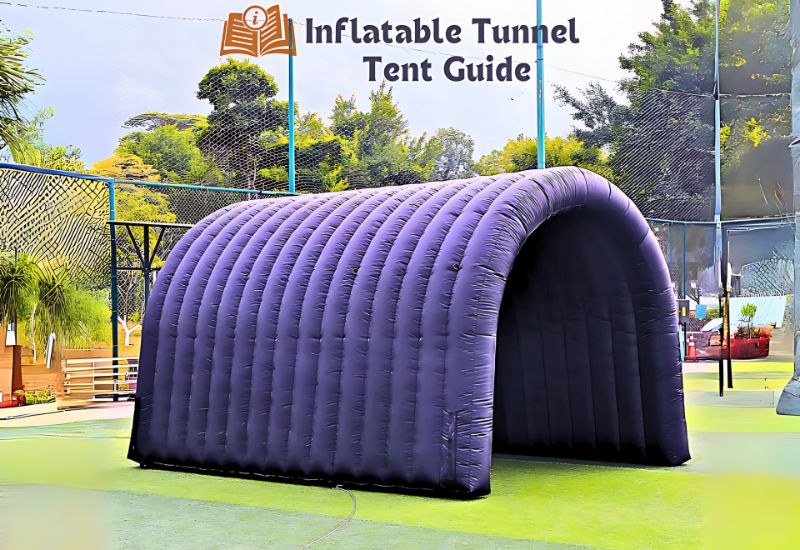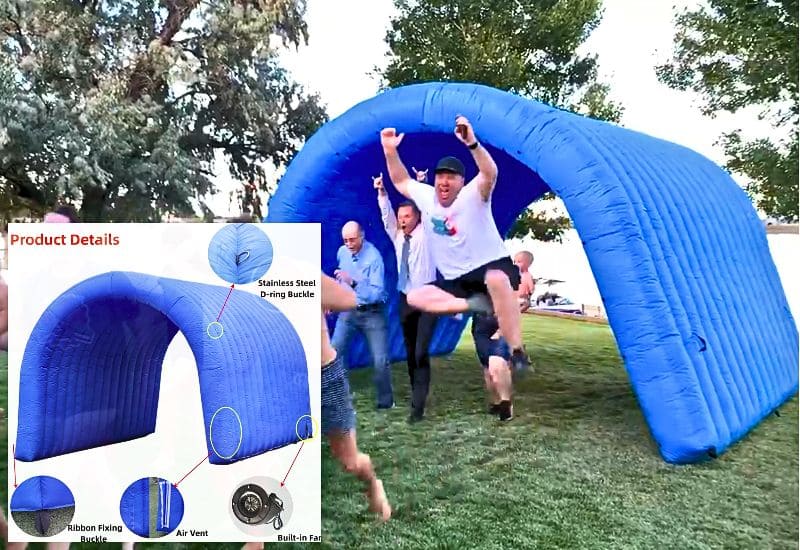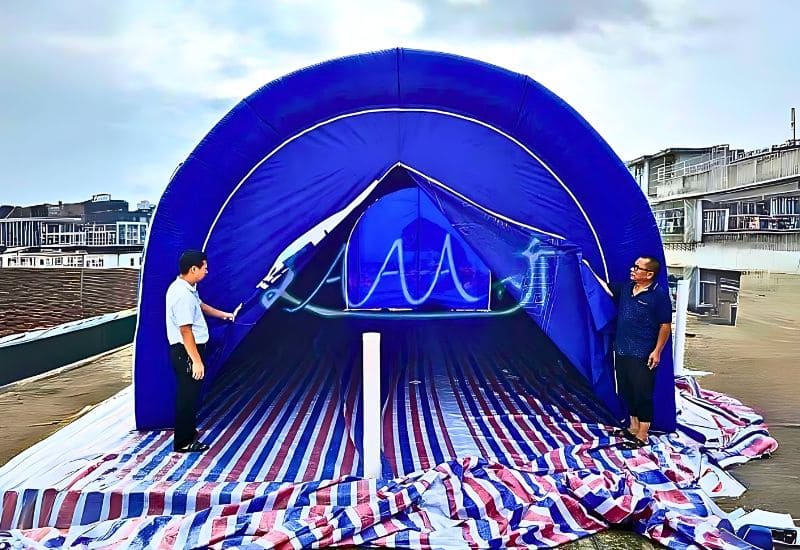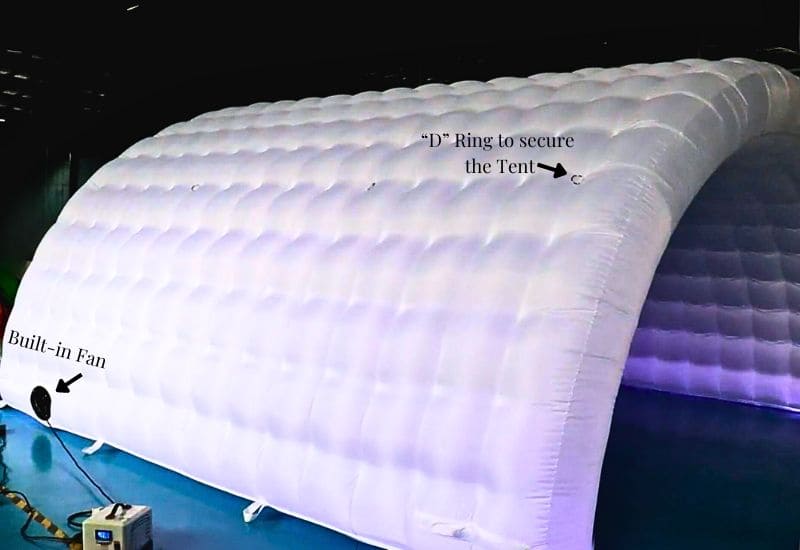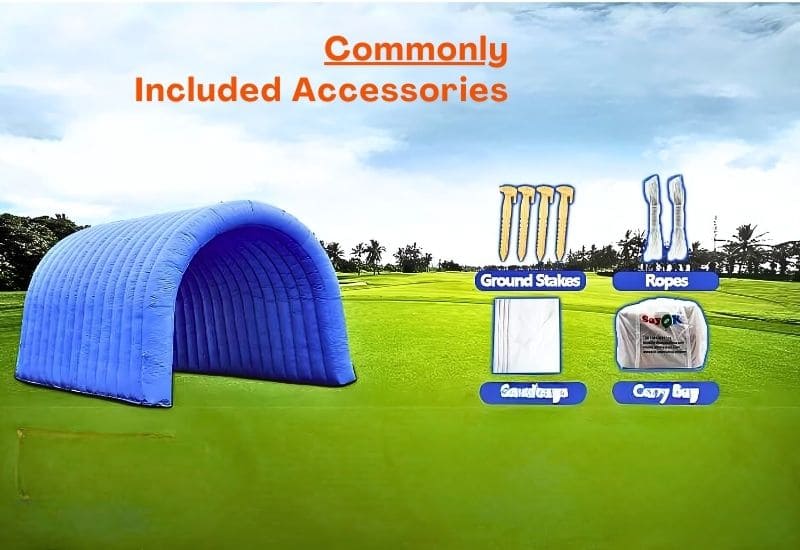Introduction to Inflatable Tunnel Tent
Discover the revolution in outdoor and event shelter solutions with inflatable tunnel tents. These innovative structures utilize air-filled beams for support, offering quick setup, portability, and versatility for various occasions. Whether you’re planning to host an event, promoting a brand, or any other outdoor activity, these durable and weather-resistant tents provide a reliable and convenient alternative to traditional tents. With options for customization and easy maintenance, inflatable tunnel tents are becoming the go-to choice for modern adventurers and event organizers.
PRODUCT REVIEWS
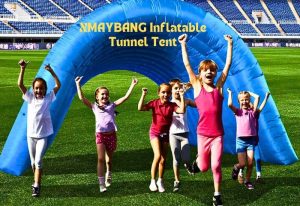
This Inflatable Tunnel Tent by XMAYBANG is a versatile and eye-catching entrance designed for various events, including sports, promotions, and exhibitions. Featuring a durable construction and an included blower for quick setup, this inflatable tunnel is perfect for attracting attention at businesses, schools, and outdoor parties. Its vibrant design ensures that your event stands out while providing a fun and engaging entryway for guests. [Read Full Review Here]
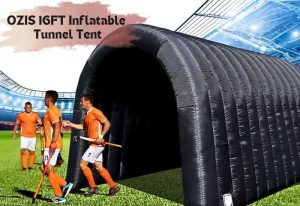
The OZIS 16FT Inflatable Tunnel is a durable and stable entrance designed for various events, made from high-quality 210D Oxford fabric with reinforced stitching and support. It features a built-in 180W blower for quick inflation in about 10 minutes and comes with essential accessories such as ropes, nails, and sandbags for stability. The tunnel measures approximately 16x10x10ft, with a wide entrance, making it suitable for promotions, exhibitions, and parties. [Read Full Review Here]
Know About the Inflatable Tunnel Tents
What Are Inflatable Tunnel Tents?
Inflatable tunnel tents are a modern type of camping shelter characterized by their elongated, tunnel-like shape and air-filled beams that provide structural support. Unlike traditional tents, which rely on poles, these tents are erected by inflating the beams with a pump, making setup quick and effortless.
These tents are designed for various outdoor activities, including family camping, festivals, and events. Their unique structure allows for increased interior space, making them suitable for larger groups. The inflatable design also enhances stability and weather resistance, offering a reliable shelter in different conditions.
Key features of inflatable tunnel tents include:
- Quick Setup: They can be pitched in minutes, reducing the hassle of traditional tent assembly.
- Lightweight and Portable: These tents are generally easier to transport due to their inflatable nature.
- Versatile Use: Ideal for a variety of outdoor settings, from casual camping to organized events.
History and Evolution of Inflatable Tents
Inflatable tents emerged in the late 20th century as a response to the demand for more convenient outdoor accommodations. The initial designs focused on simplicity and speed of setup, primarily for event use. Over the years, advancements in materials and engineering have significantly improved their durability and weather resistance.
The evolution of inflatable tents can be summarized in a few key developments:
- Material Innovation: Early inflatable tents used basic materials, but modern versions incorporate high-strength fabrics that resist punctures and UV damage.
- Design Advancements: The introduction of multi-chamber designs allows for better stability; if one section is compromised, the tent remains functional.
- Wider Applications: Initially popular for events, inflatable tents are now widely used in camping, emergency shelters, and even temporary housing solutions.
Today, inflatable tunnel tents are recognized for their ease of use and adaptability, making them a popular choice among outdoor enthusiasts.
Key Differences Between Inflatable Tunnel Tents and Traditional Tents
Inflatable tunnel tents differ significantly from traditional tents in several aspects:
- Structure: Inflatable tents use air-filled beams for support, while traditional tents rely on rigid poles. This difference affects stability, weight, and ease of setup.
- Setup Time: Inflatable tents can be set up in minutes with a pump, whereas traditional tents often require more time and effort to assemble.
- Portability: Inflatable tents tend to be bulkier when packed, but lighter in weight, while traditional tents are usually easier to pack into smaller sizes.
- Durability: Traditional tents may offer better long-term durability under harsh conditions due to their sturdy pole structure, whereas inflatable tents are susceptible to punctures but often feature multiple air chambers for added safety.
- Cost: Inflatable tents typically have a higher initial cost due to their specialized materials and design, while traditional tents can be more affordable.
These differences highlight the unique advantages and considerations for each type of tent, allowing users to choose based on their specific needs and preferences.
Materials and Construction
Types of Fabrics Used: 210D Oxford Cloth and Alternatives
210D Oxford cloth is a popular choice for inflatable tunnel tents due to its lightweight yet durable nature. This fabric is made from high-tenacity polyester yarns, providing excellent resistance to abrasion and tearing. Its waterproof properties make it suitable for outdoor use, ensuring that the tent remains dry in wet conditions.
Alternatives to 210D Oxford cloth include 420D and 600D Oxford fabrics. While 420D offers a balance of weight and durability, 600D is thicker and more robust, ideal for harsher environments. The choice of fabric often depends on the intended use of the tent, budget considerations, and desired weight. Each type of Oxford fabric has unique characteristics, such as breathability and water resistance, making them versatile options for various outdoor gear, including tents and backpacks.
Air Beams vs. Traditional Poles
Inflatable tunnel tents utilize air beams instead of traditional poles, offering several advantages. Air beams are lightweight and easy to set up, significantly reducing assembly time. They provide flexibility and can withstand wind better than rigid poles, making them suitable for various weather conditions.
Traditional poles, while sturdy, can be cumbersome and require more effort to assemble. They may also be prone to breaking under stress. In contrast, air beams distribute tension evenly across the structure, enhancing stability. This innovation in tent design not only improves user experience but also contributes to the overall durability of the tent, making air beam tents increasingly popular among campers and outdoor enthusiasts.
Durability and Longevity
The durability and longevity of inflatable tunnel tents largely depend on the materials used and the design features. Fabrics like 210D Oxford cloth are known for their strength and resistance to wear and tear, which is crucial for outdoor applications. The incorporation of PU coatings enhances the fabric’s waterproof capabilities and protects it from UV damage, extending its lifespan.
Moreover, the use of air beams instead of traditional poles contributes to the tent’s durability. Air beams are less likely to bend or break compared to metal poles, which can rust or corrode over time. Regular maintenance, such as cleaning and proper storage, also plays a vital role in prolonging the life of these tents. Overall, with the right materials and care, inflatable tunnel tents can provide reliable shelter for many camping seasons.
Setting Up Your Inflatable Tunnel Tent
Step-by-Step Setup Guide
Setting up an inflatable tunnel tent is straightforward and can be accomplished in just a few minutes. Here’s a step-by-step guide:
- 1- Preparation: Choose a flat, clear area free from sharp objects. Lay down a footprint to protect the tent floor.
- 2- Unpacking: Remove the tent from its bag and lay it out. Ensure all components are present, including the pump and any guylines.
- 3- Locate Valves: Find the inflation valves, typically one for each air beam. Open these valves to prepare for inflation.
- 4- Inflation: Use the provided pump to start inflating the beams. Begin with partial inflation to give the tent some structure, then fully inflate each beam. Monitor the pressure to avoid overinflation.
- 5- Securing the Tent: Once fully inflated, stake down the corners and attach guylines for stability, especially in windy conditions.
- 6- Final Adjustments: Ensure all doors are closed during setup. After securing the tent, you can open the doors for ventilation and set up the interior as desired.
Time Required for Setup: Quick Inflation in 3-5 Minutes
One of the major advantages of inflatable tunnel tents is their rapid setup time. Most models can be fully inflated and ready for use within 3 to 5 minutes. This efficiency is due to the air beam structure, which eliminates the need for traditional poles.
To achieve this quick setup, ensure you have a reliable pump, preferably one with a pressure gauge. Following the step-by-step guide will help streamline the process. With practice, even beginners can master the setup quickly, making these tents ideal for spontaneous camping trips or family outings.
Common Setup Mistakes and How to Avoid Them
While setting up inflatable tunnel tents is generally easy, some common mistakes can hinder the process:
- Ignoring the Ground Surface: Failing to check for sharp objects can lead to punctures. Always clear the area before laying down the tent.
- Overinflating: Exceeding the recommended air pressure can damage the beams. Always monitor the pressure and follow manufacturer guidelines.
- Neglecting Stability: Forgetting to stake down corners or attach guylines can result in instability, especially in windy conditions. Secure the tent properly to prevent it from swaying.
- Improper Ventilation: Not opening the doors during setup can trap heat and moisture inside. Ensure proper airflow to maintain a comfortable interior.
By being mindful of these common pitfalls, you can ensure a smooth and successful setup of your inflatable tunnel tent.
Customization and Design Options
Printing and Branding for Events
When hosting an event, customized branding and printing can create a memorable experience for attendees. Inflatable tunnel tents offer a unique canvas for branding, allowing you to showcase your logo, event name, or other graphics prominently. Many manufacturers offer printing services to apply your designs directly onto the tent fabric, ensuring a professional and eye-catching look. Consider using bold colors and simple designs that are easily readable from a distance. Placement of branding elements should be strategic, such as on the front or sides of the tunnel for maximum visibility.
Available Sizes and Configurations
Inflatable tunnel tents come in a variety of sizes to accommodate different event needs. Standard widths range from 3 to 6 meters, with lengths that can extend to 20 meters or more. Some models feature modular designs, allowing you to connect multiple tunnel sections together to create longer structures. When choosing a size, consider the number of people you expect to host and the activities that will take place inside the tent. Taller tents (2.5-3.5 meters) provide more headroom for standing and moving around.
Customizable Features: Windows, Doors, and Ventilation
Many inflatable tunnel tents offer customizable features to enhance functionality and comfort. Windows can be added along the sides or ends of the tent, allowing natural light to enter and providing views of the surrounding area. Transparent window panels are available for a brighter interior. Multiple doors can be positioned for easy access and traffic flow, with options like roll-up or zippered entrances. Ventilation is crucial for maintaining a comfortable temperature, especially in warm weather. Look for tents with built-in vents or the ability to add fans or air conditioning units.
Applications and Uses
Sports Events and Marathons
Inflatable tunnel tents are becoming increasingly popular for sports events and marathons. They provide a unique and eye-catching finish line or event entrance that can be customized with branding and logos. These tents are lightweight, easy to set up, and can withstand the elements, making them ideal for outdoor events. They also offer protection from the sun and rain, ensuring a comfortable experience for participants and spectators alike.
Exhibitions and Trade Shows
Inflatable tunnel tents are a fantastic choice for exhibitions and trade shows. They create a striking entrance that draws attention to your booth and helps you stand out from the competition. These tents can be designed to match your brand’s colors and logo, creating a cohesive and professional look. They are also versatile, as they can be used as a meeting area, product display, or even a small stage for demonstrations.
Parties, Camping, and Promotions
Inflatable tunnel tents are not just for large events; they can also be used for parties, camping trips, and promotions. They provide a fun and unique setting for outdoor gatherings, offering protection from the elements while still allowing for an open and airy atmosphere. These tents are easy to set up and take down, making them ideal for events where space is limited. They can also be used for product launches and promotions, as their eye-catching design is sure to attract attention and create a memorable experience for attendees. Additionally, for those interested in different types of inflatable shelters, Inflatable or Air Tents offer other versatile options that can cater to various needs and preferences.
Weather Resistance and Safety
Handling Moderate vs. Extreme Weather Conditions
Inflatable tunnel tents are designed to withstand moderate weather conditions, but their performance in extreme conditions varies depending on the specific model and construction. High-quality inflatable tents like the HEIMPLANET Cave V2 feature a geodesic plus design with multiple interconnected air beams that create a sturdy structure proven to handle harsh, windy conditions. The tent’s aerodynamic shape sheds gusts, and when staked correctly, it inspires confidence in foul weather. However, even the best inflatable tents have their limits and should be used in sheltered locations during severe storms.
Anchoring Techniques: Stakes and Guylines
Proper anchoring is crucial for the stability and weather resistance of inflatable tunnel tents. Most models come with sturdy stakes and guylines for secure setup. Most inflatable tunnel tents include pegs, guy lines, and a packing bag for easy transport. When setting up your inflatable tent, make sure to use all the provided stakes and guylines, and adjust them regularly to maintain tension. In high winds, consider using additional stakes or sandbags for extra stability.
Safety Precautions and Maintenance Tips
To ensure the safety and longevity of your inflatable tunnel tent, follow these maintenance tips:
- Always check for any damage or wear and tear before and after each use
- Clean and dry the tent thoroughly before storing it
- Store the tent in a cool, dry place away from direct sunlight
- Avoid using sharp objects near the tent to prevent punctures
- If a puncture occurs, use the included repair kit to patch it
- Consider purchasing a footprint or ground sheet to protect the tent floor
By following these precautions and maintenance tips, you can ensure that your inflatable tunnel tent remains a safe and reliable shelter for your outdoor adventures.
Maintenance and Cleaning Tips
Routine Cleaning: Using Mild Soap and Water
To maintain your inflatable tunnel tent, regular cleaning is essential. Use mild soap and water for effective cleaning without damaging the fabric. Avoid harsh chemicals, as they can compromise the tent’s waterproofing and fabric integrity.
Start by removing any dirt, debris, or stains. A soft brush can help with stubborn spots. After cleaning, thoroughly rinse the tent to eliminate any soap residue, which can attract dirt if left behind.
Drying the tent is crucial. Ensure it is completely dry before storage to prevent mold growth. If possible, pitch the tent in a well-ventilated area to speed up the drying process. Remember, keeping your inflatable tunnel tent clean not only enhances its appearance but also extends its lifespan, ensuring many enjoyable camping trips ahead.
Repairing Punctures and Replacing Air Beams
Inflatable tunnel tents are prone to punctures, but repairs can be straightforward. First, identify the damaged area by checking for air loss. You can use soapy water to help locate small leaks, as bubbles will form at the site of the puncture.
For repairs, clean the area around the puncture with an alcohol swab and let it dry. Use a suitable patching material, such as Tear Aid or Stormsure tape, ensuring it overlaps the damage by at least 2.5 cm. For larger tears, consider using a patch on both sides of the fabric for added strength.
If the air beams are damaged, replacement is necessary. Most manufacturers provide replacement kits. Follow the instructions carefully to ensure a proper fit. Regularly check your tent for signs of wear to address issues before they worsen, keeping your inflatable tunnel tent in top condition for your next adventure. For more detailed information on maintaining and using inflatable tents, you might find our Inflatable or Air Tent Guide helpful. This guide offers additional tips and options to ensure you have the best experience with your inflatable tent.
Proper Storage to Extend Lifespan
Proper storage is vital for extending the lifespan of your inflatable tunnel tent. After cleaning and ensuring it is completely dry, fold the tent neatly to avoid creases that can damage the fabric over time.
Store the tent in a cool, dry place, ideally at room temperature. Avoid areas with high humidity or extreme temperatures, as these conditions can degrade the materials.
When packing, ensure that all components, including air beams and pegs, are included to prevent loss. Consider using a storage bag that allows for airflow to prevent moisture buildup. By following these storage tips, you can ensure your inflatable tunnel tent remains in excellent condition, ready for your next outdoor adventure.
Portability and Storage Solutions
Comparing Weight and Bulk with Traditional Tents
Inflatable tunnel tents are revolutionizing camping by offering a lightweight and compact alternative to traditional tents. Unlike conventional tents that often require heavy poles and cumbersome setups, inflatable tents utilize air beams, making them significantly lighter.
- Weight Advantage: Most inflatable tunnel tents weigh considerably less than their traditional counterparts, often around 10-15 kg, which is ideal for backpackers and campers who prioritize portability.
- Bulk Reduction: When deflated, these tents can be packed into small bags, making storage and transport hassle-free. This is especially beneficial for families or groups camping together, where space is at a premium.
In summary, inflatable tunnel tents provide a practical solution for those seeking ease of transport without sacrificing space or comfort on their outdoor adventures.
Best Practices for Transporting Your Tent
Transporting inflatable tunnel tents requires careful handling to ensure longevity and performance. Here are some best practices:
- Deflate Properly: Always deflate the tent completely before packing. This prevents damage to the air beams and ensures a compact fit.
- Use the Right Bag: Store your tent in its designated carry bag to protect it from dirt and moisture during transport.
- Avoid Sharp Objects: When loading your tent into a vehicle, ensure it is kept away from sharp items that could puncture the material.
- Check Weather Conditions: If transporting in adverse weather, consider protective covers to shield the tent from rain or snow.
By following these practices, you can maintain the integrity of your inflatable tunnel tent while on the go.
Indoor vs. Outdoor Storage Considerations
When it comes to storing inflatable tunnel tents, both indoor and outdoor options have their pros and cons.
Indoor Storage:
- Protection from Elements: Storing indoors shields the tent from UV rays, moisture, and temperature fluctuations, extending its lifespan.
- Pest Prevention: Indoor storage minimizes the risk of pests damaging the tent fabric.
Outdoor Storage:
- Space Saving: If indoor space is limited, outdoor storage can be a practical solution, provided the tent is adequately covered.
- Accessibility: Keeping the tent outdoors can make it easier to access for spontaneous trips.
Ultimately, indoor storage is generally recommended for inflatable tunnel tents to ensure they remain in optimal condition, ready for your next adventure.
Accessories and Enhancements
Adding LED Lights and Banners
Incorporating LED lights into inflatable tunnel tents significantly enhances their visual appeal. These lights not only illuminate the space but also create an inviting atmosphere for events. LED lighting is energy-efficient and can be customized in various colors to match the theme of your event.
Banners are another effective way to personalize inflatable tunnel tents. They can display branding, messages, or event details prominently. Custom banners can be printed on durable materials, ensuring they withstand outdoor conditions. Combining LED lights with banners transforms your inflatable tent into a vibrant focal point, attracting attention and enhancing engagement.
Decorative Elements for Themed Events
Inflatable tunnel tents are versatile structures that can be tailored to fit any event theme. Adding decorative elements such as themed props, backdrops, and color-coordinated accessories can elevate the overall experience.
Consider using:
- Themed props: Items that resonate with your event’s concept, such as sports gear for a sports event or floral arrangements for weddings.
- Backdrops: Custom printed backdrops can enhance the visual impact and provide a great photo opportunity.
- Color schemes: Coordinating colors with your event theme can create a cohesive look.
These enhancements not only beautify the space but also create memorable experiences for attendees.
Useful Accessories for Enhanced Functionality
To maximize the functionality of inflatable tunnel tents, consider adding useful accessories. These can improve usability and enhance the overall experience for guests.
- Electric pumps: Ensure quick and easy setup with electric pumps designed for inflatable structures.
- Weight bags: Provide stability and security, especially in windy conditions.
- Connecting tunnels: These can link multiple tents together, expanding your event space.
- Flooring options: Adding flooring can improve comfort and aesthetics, making the space more inviting.
By integrating these accessories, you can create a more functional and enjoyable environment for all attendees.
Buying Guide and Cost Considerations
Price Range and What to Expect
When considering inflatable tunnel tents, prices typically range from approximately $269 to over $2,500, depending on size, brand, and features. For instance, a standard inflatable tunnel tent measuring 16.5x10x11 feet can be found for around $269, while larger, more specialized models can exceed $2,500.
Expect to pay more for tents that offer additional features such as built-in blowers, enhanced durability, and larger capacities. Here’s a quick breakdown of what you might find:
- Basic Models: $200 – $400
- Mid-Range Options: $400 – $1,000
- High-End Tents: $1,000 and above
Investing in a higher-priced tent often means better materials and more robust construction, which can enhance longevity and performance during events or outdoor activities.
Evaluating Features for Value and Suitability
When evaluating inflatable tunnel tents, consider the following features to ensure you get the best value:
- Material Quality: Look for durable fabrics like 210D Oxford cloth, which provides resistance to wear and tear.
- Size and Capacity: Choose a size that fits your needs. Tents vary significantly in dimensions, accommodating anywhere from 2 to 10+ people.
- Setup Ease: Many inflatable tents come with built-in blowers for quick inflation, making them user-friendly.
- Weather Resistance: Ensure the tent can withstand various weather conditions, especially if you’re using it outdoors.
- Portability: Consider the weight and whether it includes a carry bag for easy transport.
By focusing on these features, you can select an inflatable tunnel tent that meets your specific requirements and offers good long-term value.
Inflatable tunnel tents offer a versatile and convenient solution for a variety of events and outdoor activities. With quick setup times, durable materials, and customizable designs, they are ideal for sports events, exhibitions, and camping. While they may be bulkier and heavier than traditional tents, their ease of use and adaptability make them a popular choice for those seeking a reliable and stylish shelter. Whether for short-term events or extended outdoor adventures, inflatable tunnel tents are a practical and innovative option worth considering.

